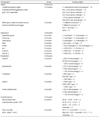1. Balliett M, Burke JR. Changes in anthropometric measurements, body composition, blood pressure, lipid profile, and testosterone in patients participating in a low-energy dietary intervention. J Chiropr Med. 2013; 12(1):3–14.
2. Choi HM, Kim JH, Lee JH, Kim CI, Song KH, Chang KJ. Nutrition in the 21st century. 3nd ed. Seoul: Kyomunsa;2011. p. 9.
3. Choi Y, Kim C, Park YS. The effect of nutrition education program in physical health, nutritional status and health-related quality of life of the elderly in Seoul. J Nutr Health. 2007; 40(3):270–280.
4. Damms-Machado A, Weser G, Bischoff SC. Micronutrient deficiency in obese subjects undergoing low calorie diet. Nutr J. 2012; 11(1):34.
5. Ellison RC, Sosenko JM, Harper GP, Gibbons L, Pratter FE, Miettinen OS. Obesity, sodium intake, and blood pressure in adolescents. Hypertension. 1980; 2(4 Pt2):78–82.
6. Grimes CA, Riddell LJ, Campbell KJ, Nowson CA. Dietary salt intake, sugar-sweetened beverage consumption, and obesity risk. Pediatrics. 2013; 131(1):14–21.
7. He FJ, MacGregor GA. A comprehensive review on salt and health and current experience of worldwide salt reduction programmes. J Hum Hypertens. 2009; 23(6):363–384.
8. He J, Ogden LG, Vupputuri S, Bazzano LA, Loria C, Whelton PK. Dietary sodium intake and subsequent risk of cardiovascular disease in overweight adults. JAMA. 1999; 282(21):2027–2034.
9. Heller M. The DASH diet weight loss solution: 2 weeks to drop pounds, boost metabolism, and get healthy, Grand central Life & style. New York: 2012. p. 1–18.
10. Imayama I, Ulrich CM, Alfano CM, Wang C, Xiao L, Wener MH, Campbell KL, Duggan C, Foster-Schubert KE, Kong A, Mason CE, Wang CY, Blackburn GL, Bain CE, Thompson HJ, Mc Tiernan A. Effects of a caloric restriction weight loss diet and exercise on inflammatory biomarkers in overweight/obese postmenopausal women: a randomized controlled trial. Cancer Res. 2012; 72(9):2314–2326.
11. Jang JY, Kim MJ, Han JS. A study on food frequency, dietary habits and nutrition knowledge of the elderly who intake high sodium. J Korean Soc Food Sci Nutr. 2009; 38(10):1362–1372.
12. Jung EJ, Son SM, Kwon JS. The effect of sodium reduction education program of a public health center on the blood pressure, blood biochemical profile and sodium intake of hypertensive adults. Korean J Community Nutr. 2012; 17(6):752–771.
13. Kant AK, Block G, Schazkin A, Ziegler RG, Nestle M. Dietary diversity in the US population, NHANES I. J Am Diet Assoc. 1987; 87(7):897–903.
14. Kim MH, Bae YJ. Evaluation of diet quality of children and adolescents based on nutrient and food group intake and deit quality index-international (DQI-I). Korean J Community Nutr. 2010; 15(1):1–14.
15. Kim S, Haines PS, Siega-Riz AM, Popkin BM. The diet quality index-international (DQI-I) provides an effective tool for cross-national comparison of diet quality as illustrated by China and the United States. J Nutr. 2003; 133(11):3476–3484.
16. Korean Society for the Study of Obesity. Obesity treatment guideline. 2012. cited December 10, 2014. Available from
http://www.kosso.or.kr/general.
17. Krebs-Smith SM, Smiciklas-Wright H, Guthrie HA, Krebs-Smith J. The effects of variety in food choices on dietary quality. J Am Diet Assoc. 1987; 87(7):897–903.
18. Kuh DL, Wadsworth M, Hardy R. Women's health in midlife: the influence of the menopause, social factors and health in earlier life. Br J Obstet Gynaecol. 1997; 104(8):923–933.
19. Lee YA, Kim KN, Chang NS. The effect of nutrition education on weight control and diet quality in middle-aged women. Korean J Nutr. 2008; 41(1):54–64.
20. Ma Y, Bertone ER, Stanek EJ 3rd, Reed GW, Hebert JR, Cohen NL, Merriam PA, Ockene IS. Association between eating patterns and obesity in a free-living US adult population. Am J Epidemiol. 2003; 158(1):85–92.
21. Ministry of Health and Welfare, Korea Centers for Disease Control and Prevention. Korea National Health and Nutrition Examination Survey (KNHANES V-3). 2013. cited October 13, 2014. Available from
https://knhanes.cdc.go.kr/knhanes/index.do.
22. Moon EH, Kim KW. Evaluation of nutrition education for hypertension patients aged 50 years and over. Korean J Community Nutr. 2011; 16(1):62–74.
23. Moon HK, Choi SO, Kim JE. Dishes contributing to sodium intake of elderly living in rural areas. Korean J Community Nutr. 2009; 14(1):123–136.
24. Moroshko I, Brennan L, O'Brien P. Predictors of dropout in weight loss intervention: a systematic review of the literature. Obes rev. 2011; 12(11):912–934.
25. Park YS, Son SM, Lim WJ, Kim SB, Chung YS. Comparison of dietary behaviors related to sodium intake by gender and age. Korean J Community Nutr. 2008; 13(1):1–12.
26. Redman LM, Heilbronn LK, Martin CK, de Jonge L, Williamson DA, Delany JP, Ravussin E. Metabolic and behavioral compensations in response to caloric restriction: implications for the maintenance of weight loss. PLoS One. 2009; 4(2):e4377.
27. Ruppert M, Diehl J, Kolloch R, Overlack A, Kraft K, Göbel B, Hitte N, Stumpe KO. Short term dietary sodium restriction increases serum lipids and insulin in salt-sensitive and saltresistant normotensive adults. Klin Wochenschr. 1991; 69(25):51–57.
28. Scagliusi FB, Ferriolli E, Pfrimer K, Laureano C, Cunha CS, Gualano B, Lourenco BH, Lancha AH. Characteristics of women who frequently under report their energy intake: a doubly labelled water study. Eur J Clin Nutr. 2009; 63(10):1192–1199.
29. Son SM, Huh GY. Dietary risk factors associated with hypertension in patients. Korean J Community Nutr. 2006; 11(5):661–672.
30. Tomiyama AJ, Mann T, Vinas D, Hunger JM, Dejager J, Taylor SE. Low calorie dieting increases cortisol. Psychosom Med. 2010; 72(4):357–364.
31. World Health Organization. Obesity: preventing and managing the global epidemic. Report of a WHO consultation. Geneva: 2004. p. 39–53.
32. Yim KS. Evaluation of the effectiveness of a nutrition education program for hypertensive patients at the community level. Korean J Community Nutr. 2000; 5(4):654–661.
33. Yoon YS, Oh SW. Sodium density and obesity; the Korea National Health and Nutrition Examination Survey 2007-2010. Eur J Clin Nutr. 2013; 67(2):141–146.
34. Yun HK, Kim HS, Chang N. Diet quality index-international score is correlated with weight loss in female college students on a weight management program. Korean J Nutr. 2009; 42(5):453–463.











 PDF
PDF ePub
ePub Citation
Citation Print
Print




 XML Download
XML Download